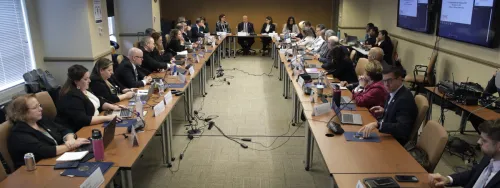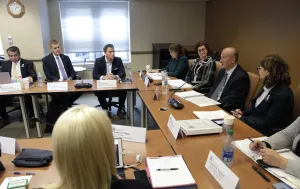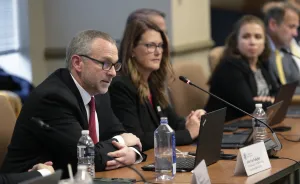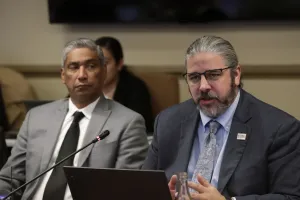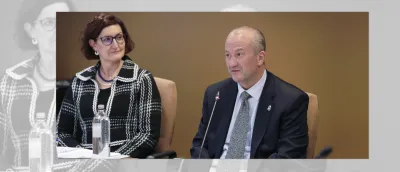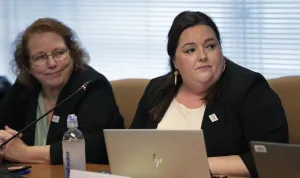By Marcy Mason
It was a time of reflection with an eye toward the future when the 16th term of U.S. Customs and Border Protection’s trade advisory committee met for their last public meeting on Dec. 13, in Washington, D.C. Members of the Commercial Customs Operations Advisory Committee, known as COAC, were recognized for their meaningful contributions and thanked for their commitment, paving the way for the committee’s 17th term.
“Service on the COAC is public service. It requires tremendous work and open minds. Our goal is to safeguard the national and economic security of the United States and facilitate the flow of goods across our borders,” said Troy A. Miller, CBP’s senior official performing the duties of the commissioner, who hosted the meeting.
“The recommendations from this committee, along with the comments we receive from the public during each quarterly meeting, are vital to these efforts. The transparency governed by the federal advisory committee process enables us to learn from diverse perspectives and expertise, and we sincerely appreciate your work.”
Miller shared special praise for the outgoing committee members. “I want to acknowledge Barry Baxter, Christopher Everley, Jose David Gonzalez, Vicente Herrera Gonzalez, Amy Smith, Jody Swentik, John Van Wallaghen, Erika Vidal-Faulkenberry, Brian White and Kathy Wilkins,” said Miller. “Your dedication and contributions to the committee have been outstanding. Your insights and expertise have played a pivotal role in providing recommendations to improve customs operations. Your passion for your respective industry sectors and commitment to facilitating smooth cross-border trade have not only impacted the committee’s work but have left a lasting imprint on the broader trade community.”
Miller highlighted some of the committee’s work over the last term. He noted that COAC had advised CBP on improving communications to better empower businesses of all sizes with forced labor withhold release orders and the Uyghur Forced Labor Prevention Act. “COAC also provided recommendations on the integration of forced labor requirements into CTPAT,” said Miller. CTPAT, or the Customs Trade Partnership Against Terrorism, is a voluntary supply chain security program that was launched in the wake of Sept. 11.
Miller also cited the COAC members for their input regarding new broker modernization regulations, which includes the transition to a national permit framework, the introduction of continuing education requirements, and their continued support for the electronic administration of the Customs Broker License Exam. Additionally, Miller pointed out that the De Minimis Working Group was created during the COAC’s 16th term. “Through this new working group and in coordination with COAC, we are committed to working with industry to identify effective solutions to disrupt global illicit supply chains while expediting legitimate trade.”
Miller thanked members of the trade community who applied for positions on the committee’s upcoming term. “We appreciate everyone’s interest,” said Miller. “With that being said, we are still in the process of determining membership for COAC’s 17th term. I look forward to announcing the next group of individuals who will take up the mantle and continue the important work of this committee."
CBP’s fight against fentanyl was another subject Miller underscored in his opening remarks. “Fentanyl has contributed to more than 100,000 overdose deaths in the United States over the last two years. Far too many of us have friends, family members, and colleagues who have been affected,” said Miller. “We know that a common pathway for fentanyl, precursor chemicals, and pill presses to get into the hands of transnational criminal organizations is through small package shipments, especially in air cargo. In fiscal year 2023, CBP cleared over one billion de minimis shipments,” he said. “While screening these shipments is incredibly challenging, CBP will continue to work with the COAC to achieve our dual mission of facilitating economic growth and trade while mitigating the risks that come with that growth.”
Other government officials shared information about new initiatives. Christa Brzozowski, the Department of Homeland Security’s assistant secretary of trade and economic security, spoke about a new DHS Supply Chain Resilience Center that was announced in late November by the Biden Administration. “This is going to be a new capability that is going to bring together the authorities, the data, and the expertise from across the many, many components of the Department that have equities that touch supply chains or the critical infrastructures that support supply chains,” said Brzozowki. The new center will analyze vulnerabilities and conduct scenario planning with private sector stakeholders to help mitigate supply chain disruptions, ensure reliable and efficient deliveries of goods and services, and lower costs for the American public.
James Mancuso, director of Homeland Security Investigations’ Intellectual Property Rights Center, shared how HSI is using $7 million of enhancement funding to expand upon a core initiative of the IPR Center called Operation Chain Reaction. “The genesis of the IPR Center was looking at counterfeits entering the government military supply chain and the vulnerability of the threats they pose,” said Mancuso. “Now, we’re looking at an area of the U.S. government that we haven’t explored. We’re looking at the vulnerabilities in the Veteran’s Administration. The VA has one of the largest online pharmacies in the world, and the threat to our veterans with counterfeit, illicit medicines and counterfeit medical devices entering the VA supply chain is significant. It’s a serious issue and it’s something we are taking very seriously.”
Mancuso also told those attending the meeting that the IPR Center had received 36,000 investigative leads last year. “Half the leads came from CBP and half the leads came from the private industry,” said Mancuso. “We’re trying to create a threat matrix to really drill down those leads and pick the most egregious violators. We bid out to those illegal procurement networks and get those leads to the men and women in the field for action. That’s our goal at the IPR Center. That’s something we do every day and we do it very well.”
Trade co-chair Kathryn Wilkins, the vice president of logistics consulting firm Alliance Operating Services, expressed the committee’s appreciation while speaking on behalf of the COAC. “This is our last meeting of the 16th term. We’ve all had a great time and the experience that we’ve had with COAC has been invigorating. Looking at what Customs sees and does on a daily basis and actually getting to work with CBP on the problems confronting the trade community is something none of us were expecting,” said Wilkins. “We knew that CBP wanted some ideas, but we didn’t know what the agency would do with them. So, the transparency that CBP has brought to the table with the idea of modeling it for something that is good for trade has been super appreciated.”
COAC member John Drake, the vice president for supply chain policy at the U.S. Chamber of Commerce, reminded attendees about COAC’s position regarding the 21st Century Customs Framework initiative, which is CBP’s effort to help advance transformational reforms needed to bring U.S. trade into the 21st century. “There is growing interest and attention around modernizing our nation’s customs laws. The COAC recognizes the importance of customs and trade modernization,” said Drake. But he noted that “the COAC did not endorse CBP’s 21st Century Customs proposal due to the lack of meaningful legislative facilitation measures. We adopted this position following lengthy discussions with CBP where we advised the agency of revisions to specific draft legislative concepts to streamline and enhance the agency’s authorities,” said Drake. “These discussions resulted in CBP revising the legislative proposals in ways that are more palatable in the trade community compared to what was originally presented.”
The COAC presented final recommendations on CBP’s 21st Century Customs Framework proposals in June 2022, marking a major accomplishment of the 16th term. During the process, which began in the 15th term, CBP shared 24 proposed drafts with COAC’s 21st Century Customs Framework Task Force. The COAC recommended that 18 of CBP’s amended drafts be included in CBP’s 21st Century Customs Framework proposal.
The meeting also included updates on trade programs and COAC subcommittee work. “The work done over the last quarter as well as the last term has been extensive,” said Susan Thomas, CBP’s executive director of Cargo and Conveyance Security. “The issues that you’ve addressed all were on my list when I came into this position at the end of August. Exports, in-bond, cross-border, CTPAT, de minimis, the industry centers—all of these are things that really do keep me up at night. So, I am glad that we can work together to address these pertinent issues.”
A total of 12 recommendations were presented and unanimously passed at the meeting. Of these recommendations, eight pertained to export modernization, two addressed in-bond issues, and two focused on the U.S.-Mexico-Canada Agreement.
Announcements were made regarding the upcoming CBP Trade Facilitation and Cargo Security Summit, which will be held March 26-28, 2024, in Philadelphia, and the next COAC meeting scheduled for March 6, 2024, in Charleston, South Carolina.
COAC is a 20-member advisory committee established by Congress in 1987. The committee provides advice and recommendations to CBP and the Department of the Treasury on their trade-related functions and the commercial operations of CBP. Some of the issues COAC focuses on include enhanced border and supply chain security, international efforts to harmonize customs practices and procedures, import safety, compliance, and modernization and automation processes used to facilitate trade.


